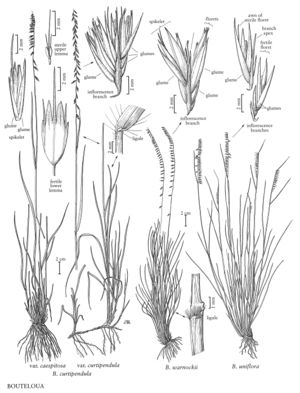familyPoaceae
subfamilyPoaceae subfam. Chloridoideae
genusBouteloua
subgenusBouteloua subg. Bouteloua
speciesBouteloua curtipendula
Difference between revisions of "Bouteloua curtipendula var. caespitosa"
Treatment appears in FNA Volume 25. Treatment on page 254.
imported>Volume Importer |
imported>Volume Importer |
||
| (One intermediate revision by the same user not shown) | |||
| Line 38: | Line 38: | ||
|publication year= | |publication year= | ||
|special status= | |special status= | ||
| − | |source xml=https:// | + | |source xml=https://bitbucket.org/aafc-mbb/fna-data-curation/src/200273ad09963decb8fc72550212de541d86569d/coarse_grained_fna_xml/V25/V25_869.xml |
|subfamily=Poaceae subfam. Chloridoideae | |subfamily=Poaceae subfam. Chloridoideae | ||
|tribe=Poaceae tribe Cynodonteae | |tribe=Poaceae tribe Cynodonteae | ||
Latest revision as of 18:59, 11 May 2021
Plants cespitose, often with a knotty base, not or shortly rhizomatous. Culms in large or small clumps, stiffly erect. Blades usually narrow, but at least some over 2.5 mm wide. Panicles with 12-80 branches, averaging 2-7 spikelets per branch. Glumes and lemmas bronze or stramineous to green, or various shades of purple; anthers usually yellow or orange, occasionally red or purple. 2n = 58-103.
Distribution
Loading map...
Okla., N.Mex., Tex., Utah, Calif., Colo., Ariz.
Discussion
Bouteloua curtipendula var. caespitosa grows on loose, sandy or rocky, well drained limestone soils at 200-2500 m in the southwestern United States, Mexico, and South America. It frequently grows, and may hybridize, with B. warnockii.
Selected References
None.
Lower Taxa
None.
... more about "Bouteloua curtipendula var. caespitosa"
